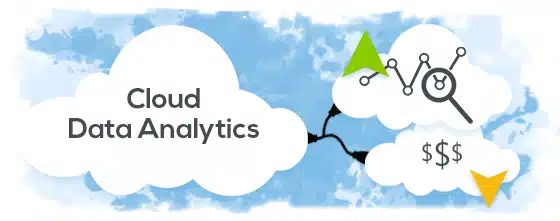In today’s data-driven world, choosing the right cloud data warehousing solution is imperative for businesses to stay competitive. In this comprehensive guide, we will be exploring the ins and outs of the Snowflake Data Cloud, offering an in-depth analysis of the platform and its capabilities.
- Brief Overview of the Snowflake Data Cloud
- Importance of Cloud Data Warehousing in Modern Business
- Cost Components of the Snowflake Data Cloud
- Real-World Use Cases and Benefits of Snowflake
- Challenges and Considerations When Implementing Snowflake
- How Dilytics Can Streamline Your Snowflake Data Cloud Implementation
- Conclusion
From its innovative features to its cost components, we will provide a detailed overview of what Snowflake can offer to businesses of all sizes. As a leading solution in the data warehousing sector, understanding the benefits and potential challenges of this platform is crucial for informed decision-making.
Key Takeaways
- Gain a better understanding of the Snowflake Data Cloud, and how it compares to other data warehousing solutions in the market.
- Delve into the importance of cloud data warehousing in modern business, and explore Snowflake’s unique features and advantages.
- Learn about the cost components of the Snowflake Data Cloud, including an analysis of its pricing model, storage costs, compute costs, and data transfer costs.
- Discover real-world use cases of companies benefiting from Snowflake’s capabilities, as well as success stories that highlight the platform’s potential.
- Consider the challenges and best practices when implementing Snowflake, and learn how partnering with a knowledgeable solutions provider like Dilytics can streamline the process while optimizing costs.
Brief Overview of the Snowflake Data Cloud
The Snowflake Data Cloud is a cutting-edge, cloud-based data storage and analytics solution that is transforming the way businesses access, analyze, and share data.
As the demand for real-time insights and data-driven decision-making grows exponentially, Snowflake’s Data Cloud provides a unified platform to efficiently manage data across multiple public clouds and private data centers.
Launched in 2012 by Benoit Dageville, Thierry Cruanes, and Marcin Zukowski, Snowflake has rapidly emerged as a leading player in the cloud data warehousing space, attracting a wide range of clients.
The platform’s unique architecture and innovative features position it ahead of traditional data warehouses, offering scalable, secure, and cost-effective solutions for modern businesses.
At the core of Snowflake’s Data Cloud is its multi-cluster, shared data architecture that enables seamless and secure data sharing across organizations. This facilitates unprecedented collaboration and opens the door for advanced analytics. Notable features of the platform include:
- Cloud-based data storage and processing: Snowflake’s managed storage service integrates with major cloud platforms like AWS, Google Cloud, and Microsoft Azure, allowing businesses to benefit from their cloud infrastructure.
- Automatic scaling: Snowflake’s data warehousing service scales up and down on-demand, providing consistent performance and cost-efficiency as data volumes increase.
- Flexible data ingestion: Snowflake supports several methods of loading data, including continuous data pipelines and bulk data loading from various data sources.
- Data sharing: Snowflake enables users to create and share live, read-only views of data with external partners, granting secure access without copying or transferring data.
- Advanced security: Snowflake provides end-to-end data encryption, multi-factor authentication, and role-based access control, ensuring data privacy and compliance.
As businesses venture into the era of big data and digital transformation, Snowflake’s Data Cloud stands at the forefront of change, providing a powerful analytics solution for organizations seeking actionable insights.
In the subsequent sections, we will dive deeper into the value Snowflake’s Data Cloud can bring to your business and examine its pricing model to help you make an informed decision on the right data warehousing solution for your needs.
Also Read: What is HR analytics software?
Importance of Cloud Data Warehousing in Modern Business
In today’s data-driven business environment, effective management and analysis of enterprise data are essential for competitive advantage. As businesses create and consume vast amounts of data, traditional data warehouses struggle to keep up with the demand for scalable and flexible data storage and analytics solutions. Cloud data warehousing is emerging as a pivotal technology, enabling organizations to meet the challenges of the modern business landscape.
In this context, the Snowflake Data Cloud stands out as a purpose-built cloud data warehousing platform that caters to modern data storage and analytics needs.
Understanding the Snowflake Data Cloud
Snowflake is a fully managed, SQL-based cloud data warehousing service designed to meet the needs of businesses at scale. Its unique architecture is built from the ground up to leverage the cloud’s elasticity and scalability.
With a multi-cluster, multi-cloud approach, Snowflake enables organizations to store and process vast amounts of structured and semi-structured data across various cloud platforms. By decoupling storage and compute operations, Snowflake provides businesses the flexibility to pay only for the resources they consume, avoiding lock-ins and vendor dependencies.
Key Features and Capabilities
The Snowflake Data Cloud delivers a wide range of features that place it ahead of traditional data warehouses. Some of its key features and capabilities include:
- Elasticity and scalability: Snowflake’s architecture allows for seamless scaling of storage and compute requirements, enabling users to match performance with ever-changing data demands.
- Multi-cluster: Snowflake’s unique multi-cluster, shared data architecture allows users to run multiple concurrent workloads, eliminating resource contention and ensuring consistent performance across user groups.
- Multi-cloud architecture: Snowflake supports deployment across all major public cloud platforms, including AWS, Azure, and Google Cloud Platform, providing greater flexibility and optimal choice in cloud infrastructure.
- Data sharing and collaboration: Snowflake’s data-sharing capabilities allow businesses to share data across departments or with external partners, fueling collaboration and driving insights throughout the entire data ecosystem.
Advantages of Snowflake Over Traditional Data Warehouses

Snowflake’s modern approach to data warehousing propels it ahead of traditional data warehouses, offering notable advantages such as:
- Agility: With its ability to rapidly scale compute and storage resources, Snowflake enables businesses to respond faster to changes in data volumes and demand for analytics.
- Lower total cost of ownership (TCO): By employing a pay-as-you-go model for both storage and computing, Snowflake can help reduce overall TCO by more efficiently utilizing resources based on actual usage patterns, as opposed to maintaining expensive on-premises infrastructure.
- Better performance: Snowflake’s unique architecture and optimization techniques ensure query performance is consistently fast, regardless of data size or concurrency levels.
- Enhanced security: Because Snowflake is a fully managed service, businesses benefit from the robust security mechanisms built into the platform, with data encryption both at rest and in transit, as well as comprehensive access control and audit capabilities.
- Streamlined data sharing and collaboration: Snowflake’s secure data-sharing features empower organizations to seamlessly share data within their organization or to external partners, without requiring ETL pipelines or data duplication.
In conclusion, the Snowflake Data Cloud is a standout choice for businesses seeking a modern, efficient, and scalable cloud data warehousing solution. Its innovative architecture and features set it apart from traditional data warehouses, significantly enhancing data management, analytics capabilities, and cost efficiency.
Cost Components of the Snowflake Data Cloud
Understanding the cost components of Snowflake Data Cloud is crucial for businesses considering its adoption. An overview of Snowflake’s pricing model, including storage costs, compute costs, and data transfer costs, can help companies make informed decisions. This section will dissect the pricing model and discuss factors that contribute to pricing variations.
Note that Snowflake pricing is subject to change, and businesses should refer to the latest information on their official website for the most accurate cost structure.
Overview of Snowflake Pricing Model
Snowflake offers a consumption-based pricing model, which consists of three primary components: storage, compute, and data transfer. The cost for each component is charged separately, allowing users to better optimize and control their expenses:
- Storage costs: They are based on the amount of data stored in Snowflake Data Cloud. Storage is billed monthly and calculated per terabyte (TB) of data stored.
- Compute costs: These costs are associated with running workloads, such as executing queries, and are charged on a per-second basis. Compute resources used in Snowflake are known as virtual warehouses. The pricing depends on the type and size of the virtual warehouse, with larger sizes consuming more credits per hour.
- Data transfer costs: They cover charges associated with moving data between cloud regions and providers. However, movement of data within the same region or between stages is not charged.
Additionally, the pricing varies based on the Snowflake edition (Standard, Enterprise, or Business Critical) and the cloud provider selected by the user (e.g., Amazon Web Services, Microsoft Azure, Google Cloud Platform).
Storage Costs in Snowflake Data Cloud
As storage costs depend on the amount of data stored in Snowflake Data Cloud, it is important to ensure efficient usage of storage resources. For example:
Snowflake charges $23 per TB per month for storage in the Standard edition. With 200 TB of data stored, the total monthly storage cost would be $4,600.
Compute Costs in Snowflake Data Cloud
Compute costs can vary significantly depending on the type and size of virtual warehouses used to run workloads. Snowflake offers a range of sizes:
| Size | Description | Credits per Hour |
|---|---|---|
| X-Small | Smallest warehouse for quick queries and testing | 1 |
| Small | Suitable for small to medium-sized workloads | 2 |
| Medium | Ideal for larger workloads and analytics | 4 |
| Large | Designed for big data processing or high concurrency workloads | 8 |
| X-Large | Used for the largest data workloads with demanding performance requirements | 16 |
Remember that compute resources are charged on a per-second basis, only when utilized. Scaling virtual warehouses up or down, or pausing them when not in use, can optimize compute costs.
Data Transfer Costs in Snowflake Data Cloud
Although data transfer costs may generally be lower than storage and compute costs, businesses should be mindful of unnecessary data movement between regions and cloud providers. Reducing data transfer operations can minimize the overall cost.
In conclusion, understanding and managing the cost components of Snowflake Data Cloud efficiently is essential for businesses to maximize cost optimization. By gaining a clear overview of the pricing model, storage, compute, and data transfer costs, companies can make informed decisions and tailor their Snowflake usage to suit their specific requirements.
Real-World Use Cases and Benefits of Snowflake
Managing vast amounts of data and transforming it into meaningful insights is the need of the hour for businesses worldwide. Snowflake Data Cloud allows organizations to achieve that. In this section, we will explore some real-world use cases, examples of companies benefiting from Snowflake Data Cloud, and the success stories and lessons learned during their journeys with Snowflake.
Examples of Companies Benefiting from Snowflake Data Cloud
Several organizations across different industries have benefited from the Snowflake Data Cloud, showcasing its effectiveness and versatility.
- Capital One: The US-based bank leveraged Snowflake’s cloud data platform for its analytics workloads, reducing operational complexity and resource constraints.
- Logitech: The multinational computer peripherals company utilized Snowflake to improve its data-driven decision-making processes, bringing about substantial enhancements in business efficiency and customer experience.
- Pinterest: By transitioning to Snowflake, the popular social media platform streamlined data sharing and collaboration, leading to more accurate analytics and improved product innovation.
- Sony Interactive Entertainment: Adopting Snowflake’s platform, the company consolidated its global data pipelines and experienced significant analytics performance improvements.
Success Stories and Lessons Learned
Besides the examples mentioned earlier, several other companies have witnessed the transformative power of Snowflake Data Cloud. Let us delve deeper into these success stories and draw meaningful lessons from their experiences.
“Snowflake’s cloud platform allowed us to implement a scalable and flexible data infrastructure that delivered powerful and actionable insights for our stakeholders.”
– Data Architect, DoorDash
DoorDash, an on-demand food delivery platform, overcame multiple data warehousing challenges with Snowflake. The flexibility and scalability provided by Snowflake allowed DoorDash to handle considerable increases in data ingestion and query rates. The company no longer needed to manage infrastructure manually, which freed up time and resources for other critical projects.
| Company | Industry | Benefits Gained from Snowflake |
|---|---|---|
| iHeartMedia | Media and Entertainment | Smooth data migration, integrated data analytics, and reduced data processing times |
| Instacart | Grocery Delivery | Elimination of query bottlenecks, improved data pipeline efficiency, and real-time analytics |
| Sportsbet | Online Betting | Agile data management, faster analytics, and simplified compliance with regulations |
| Upwork | Freelance Marketplace | Enhanced data integration, swift data queries, and significant cost savings |
These success stories emphasize the effectiveness of Snowflake Data Cloud across various industries and business scales. Drawing lessons from these experiences, organizations can leverage Snowflake to unlock new growth opportunities and transform the way they handle data-related challenges. For potential users, the practical benefits derived from these case studies provide added confidence in choosing Snowflake as the optimal cloud data warehousing solution.
Challenges and Considerations When Implementing Snowflake
Despite the numerous advantages provided by the Snowflake Data Cloud, organizations should approach its implementation with a thorough understanding of potential challenges and best practices for optimizing costs. This section offers insights into these obstacles and presents practical recommendations for ensuring a successful transition.
Potential Challenges
- Data migration: One of the primary challenges when transitioning to Snowflake is the migration of existing data and structures. This process can be time-consuming and complex, requiring meticulous planning and execution to avoid downtime and data loss.
- Resource management: Snowflake’s unique architecture provides immense scalability, but this can also lead to overspending if not managed properly. Businesses must find the right balance of computing and storage resources to align with their budget and performance requirements.
- Training and support: As with any new technology, upskilling the team and providing continuous support is key for a smooth transition. Organizations may encounter resistance or struggles during the initial stages, especially considering Snowflake’s distinct framework and functions.
- Data security and compliance: Ensuring data protection, privacy, and regulatory compliance while leveraging cloud data warehouses is essential. Businesses must acquaint themselves with Snowflake’s security measures and align their existing policies and protocols with the new solution.
To mitigate these challenges and optimize costs, the following best practices should be implemented:
Best Practices for Cost Optimization
| Best Practice | Description |
|---|---|
| Effective data migration strategy | Create a detailed migration plan with clear timelines, milestones, and contingencies to ensure a streamlined process. |
| Monitor resource usage | Regularly evaluate storage and computing needs, and adjust resources accordingly to avoid both underutilization and overspending. |
| Optimized warehouse configuration | Configure virtual warehouses based on the specific requirements of different workloads to achieve cost efficiency without sacrificing performance. |
| Staff training and support | Invest in comprehensive training sessions, user guides, and ongoing support for employees to facilitate a smoother transition. |
| Data security and compliance checks | Perform regular security and compliance audits, and utilize Snowflake’s built-in security features, such as encryption, to fortify data protection. |
In conclusion, effectively addressing the challenges associated with implementing Snowflake requires careful planning, resource management, and staff engagement. By adopting the best practices highlighted above, organizations can ensure a successful transition, driving cost optimization and peak performance.
How Dilytics Can Streamline Your Snowflake Data Cloud Implementation
When it comes to implementing the Snowflake Data Cloud, engaging with an experienced partner like Dilytics can be the key to success. Bringing comprehensive experience and deep expertise in Snowflake implementation, Dilytics offers tailored solutions designed to meet the unique needs of businesses of all sizes. In this section, we will delve into the benefits of engaging with Dilytics and take a look at a few case studies that showcase successful Snowflake implementations.
Introduction to Dilytics and Their Expertise in Snowflake
Dilytics is a leading provider of data management and analytics solutions, helping businesses achieve optimal performance in handling, storing, and analyzing their data. With a strong focus on providing customized solutions, the company has garnered a reputation for its proficiency in Snowflake implementation and has partnered with a diverse array of businesses seeking to leverage the power of the Snowflake Data Cloud.
Boasting a team of certified Snowflake professionals, Dilytics ensures that organizations unlock the full potential of Snowflake to propel their businesses forward. The company’s comprehensive expertise ranges from data architecture design, data integration, and data modeling to optimization of Snowflake usage and cost management.
Tailored Solutions for Businesses of All Sizes
Understanding that no one-size-fits-all approach guarantees success, Dilytics places great importance on developing tailored solutions that cater to the unique needs of each business. With experience in supporting small start-ups as well as large enterprises, Dilytics has proven that their adaptable and innovative approach can drive success for organizations across various industries.
“Dilytics catered to our unique needs by crafting a tailored Snowflake implementation plan that optimized our data and analytics strategy. Their expertise and personalized approach exceeded our expectations.” — A satisfied Dilytics client.
Conclusion
In summary, the Snowflake Data Cloud offers a powerful solution for businesses seeking to take advantage of cloud data warehousing. By understanding its unique features and pricing model, businesses can effectively leverage Snowflake to meet their data storage and analytics needs. When it comes to implementing this technology, selecting a knowledgeable partner like Dilytics is critical. They can offer tailored solutions and cost optimization strategies to ensure a seamless adoption process.
As cloud data warehousing continues to evolve, businesses must stay informed of future trends in the industry. One key trend to watch for is the increasing importance of real-time analytics, as well as the growing adoption of machine learning and artificial intelligence for advanced data processing. The emphasis on data security and privacy is also expected to grow further, making it vital for businesses to invest in secure and compliant data management solutions.
By engaging with a partner like Dilytics, businesses can ensure that they stay ahead of these trends and leverage the full power of the Snowflake Data Cloud. This will enable them to drive innovative solutions, informed decision-making, and maintain a competitive advantage in an increasingly data-driven world.




